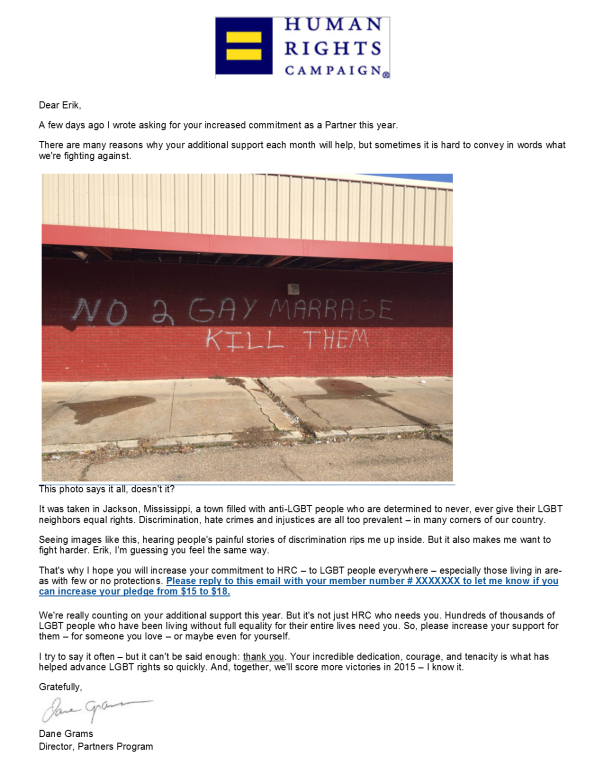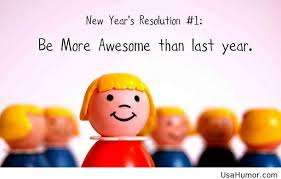On January 8th, I wrote a post titled “Fundraising New Year’s Resolution — Upgrade Strategy,” which contained a few tips about how your non-profit organization can achieve this important strategy. After writing that post, I wished that I had a sample to share with you . . . and then a few weeks ago I received an email from Dane Grams at Human Right Campaign (HRC).

Did you notice the following:
- The case for support was simply captured without saying a word? A picture is worth a 1,000 words!
- Philanthropy is an emotional activity and the case evoked lots of emotion.
- He didn’t bombard me with lots of stats. He didn’t try to tell me how often this type of thing happens in America. He simply pulled an emotional trigger and got out of the way.
- He asked for a specific dollar amount increase.
- He made it easy to say YES . . . just click the link.
- He thanked me for my ongoing support and participation in their monthly giving program.
Tom Ahern, one of our country’s smartest donor communications experts, says all the time that good appeals contain at least one of the following emotional triggers:
- anger
- exclusivity
- fear
- flattery
- greed
- guilt
- salvation
How many of those triggers can you see in the letter above?
If you want to learn how to get better at donor communications, I suggest checking out Tom Ahern’s books, videos and resources. If you want to learn more about monthly giving programs, Pamela Grow has a really nice four week distance learning online course. If you want to get better at creating upgrade opportunities, keep your eyes open because some of your peers in the non-profit sector have gotten really good at it. As I say in many of my blog posts . . . we can learn from each other!
I’m sure you’re wondering if I clicked that upgrade button. You’re damn straight I did! I didn’t even think twice about doing it, which is how I know it was a very effective appeal.
Have you seen a really good upgrade strategy (e.g. mail, email, etc)? Please feel free to email it to me, and I’ll be happy to share it with the rest of the DonorDreams blog community. I will, of course, scrub it of your personal into and protect your identity.
Please scroll down and share your thoughts and experiences in the comment box below.
Here’s to your health!
Erik Anderson
Founder & President, The Healthy Non-Profit LLC
www.thehealthynonprofit.com
erik@thehealthynonprofit.com
http://twitter.com/#!/eanderson847
http://www.facebook.com/eanderson847
http://www.linkedin.com/in/erikanderson847

 Like most Americans, I took a little time for myself at the end of 2014. I spent some of it celebrating the holidays with my family. I spent a little more of it celebrating the nuptials of an old friend. I spent the remainder of it in Napa Valley ringing in the new year over a few nice bottles of wine. While recharging my batteries, I came across a USA Today article from John Waggoner titled “
Like most Americans, I took a little time for myself at the end of 2014. I spent some of it celebrating the holidays with my family. I spent a little more of it celebrating the nuptials of an old friend. I spent the remainder of it in Napa Valley ringing in the new year over a few nice bottles of wine. While recharging my batteries, I came across a USA Today article from John Waggoner titled “ As a donor, I discovered long ago that if I want to make a large contribution to a non-profit organization it probably won’t happen by writing one large check. While some people on this planet have that capacity, my bank account balance isn’t fat enough to do something like Bill Gates or Warren Buffet. However, “large contribution” is a relative term, and I made my first meaningful, sacrificial gift at the age of 27 when I pledged $1,000 to a local Boy Scout council while earning $27,000 working for that same organization.
As a donor, I discovered long ago that if I want to make a large contribution to a non-profit organization it probably won’t happen by writing one large check. While some people on this planet have that capacity, my bank account balance isn’t fat enough to do something like Bill Gates or Warren Buffet. However, “large contribution” is a relative term, and I made my first meaningful, sacrificial gift at the age of 27 when I pledged $1,000 to a local Boy Scout council while earning $27,000 working for that same organization. The United Way figured this one out a long time ago, didn’t they?
The United Way figured this one out a long time ago, didn’t they? Since the Great Recession of 2008, many non-profit organizations have explored and developed monthly giving programs. This strategy has been very popular with European charities, and it is akin to the “set it and forget it” mentality of our society.
Since the Great Recession of 2008, many non-profit organizations have explored and developed monthly giving programs. This strategy has been very popular with European charities, and it is akin to the “set it and forget it” mentality of our society.